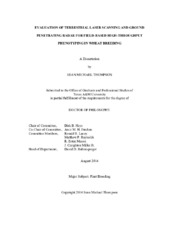| dc.contributor.advisor | Hays, Dirk B | |
| dc.contributor.advisor | Ibrahim, Amir MH | |
| dc.creator | Thompson, Sean M | |
| dc.date.accessioned | 2015-02-05T21:23:08Z | |
| dc.date.available | 2016-08-01T05:30:14Z | |
| dc.date.created | 2014-08 | |
| dc.date.issued | 2014-08-05 | |
| dc.date.submitted | August 2014 | |
| dc.identifier.uri | https://hdl.handle.net/1969.1/153661 | |
| dc.description.abstract | Targeted adaptive physiological trait introgression, a method by which breeders seek to introduce specific characteristics into breeding germplasm in a specific and targeted manner, is one of the primary methods breeders are using to develop cultivars optimized for performance and yield under heat and drought conditions. In traditional breeding platforms, this is carried out in a stepwise fashion, with the crossing of parental lines and the phenotype-driven selection of offspring.
As with other adaptive physiological traits, rapid field-based high-throughput phenotyping of early season aboveground biomass and ideal root architecture is limited by our inability to accurately and nondestructively characterize these important traits. Terrestrial laser scanning (TLS) and ground penetrating radar (GPR) have the potential to fill this gap by non-invasively estimating biomass and mapping three-dimensional above- and below-ground vegetation.
The research objective was to evaluate the use of TLS to estimate aboveground wheat (Triticum aestivum L.) biomass. Linear regressions comparing mean canopy height and total plot forage yield for each experimental plot across four replications was poorly correlated (R^2 0.08). Mean plot normalized difference vegetation index measurements were evaluated against total plot forage biomass with limited correlation (R^2 0.036). The mean value of the TLS elevation points had the highest correlation with both plot (R^20.09458) and sub plot (R^2 0.37984) forage yield as compared to traditional platforms.
GPR is a remote sensing technology that has been successfully used in the evaluation of coarse tree root biomass. Incorporating GPR into current crop phenotyping methodologies could potentially provide a long awaited solution to the current inability to efficiently phenotype roots under realistic field conditions. Here, the utility of using GPR to estimate root biomass of wheat was evaluated. GPR ability to predict root presence and absence was tested and GPR was able to differentiate root mass from soil significantly (α = 0.95, t = 1.96022). Linear regression between Log10 of the mean GPR amplitude return at the 0-3 ns range was compared with agronomic breeding traits. Overall increased amplitude was observed in plots scoring higher with regard to overall yield and yield components. | en |
| dc.format.mimetype | application/pdf | |
| dc.language.iso | en | |
| dc.subject | Ground Penetrating Radar | en |
| dc.subject | Terrestrial Laser Scanning | en |
| dc.subject | Phenotyping | en |
| dc.subject | Wheat | en |
| dc.title | Evaluation of Terrestrial Laser Scanning and Ground Penetrating Radar for Field-Based High-Throughput Phenotyping in Wheat Breeding | en |
| dc.type | Thesis | en |
| thesis.degree.department | Soil and Crop Sciences | en |
| thesis.degree.discipline | Plant Breeding | en |
| thesis.degree.grantor | Texas A & M University | en |
| thesis.degree.name | Doctor of Philosophy | en |
| thesis.degree.level | Doctoral | en |
| dc.contributor.committeeMember | Lacey, Ronald E | |
| dc.contributor.committeeMember | Reynolds, Matthew P | |
| dc.contributor.committeeMember | Mason, Richard E | |
| dc.contributor.committeeMember | Miller, Jr., Julien C | |
| dc.type.material | text | en |
| dc.date.updated | 2015-02-05T21:23:08Z | |
| local.embargo.terms | 2016-08-01 | |


